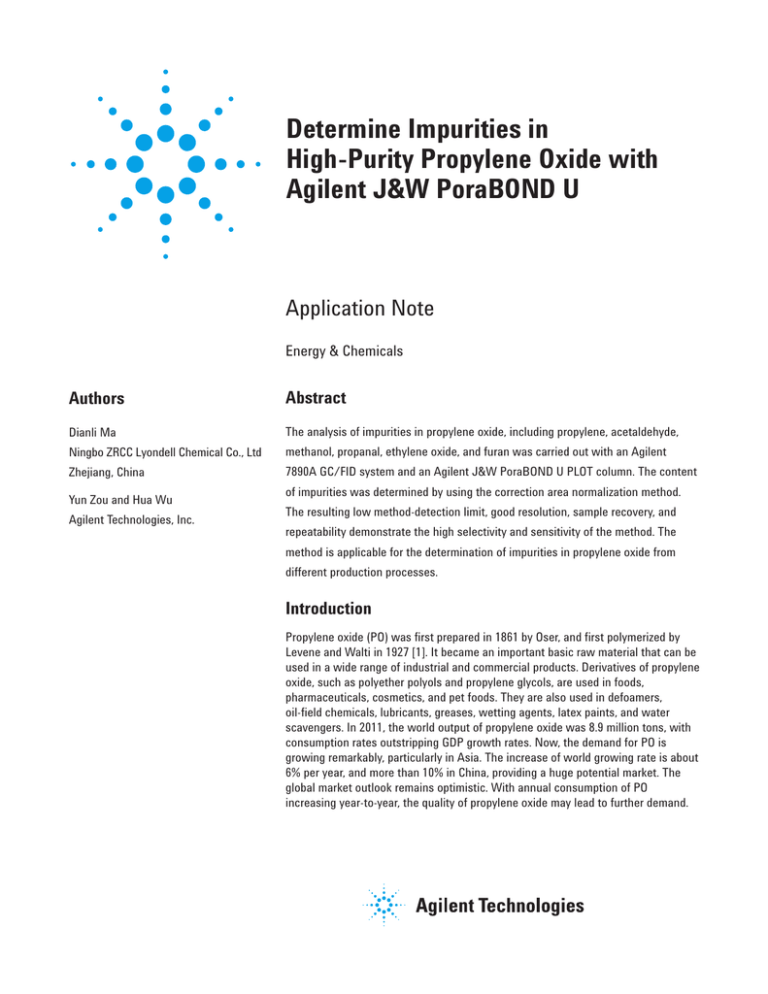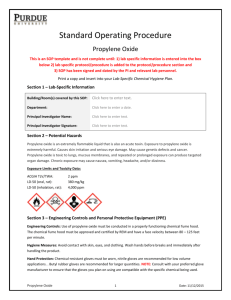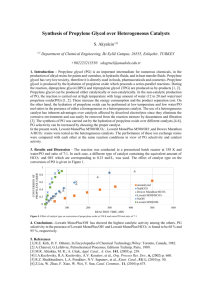Determine Impurities in High-Purity Propylene Oxide with Agilent
advertisement

Determine Impurities in High-Purity Propylene Oxide with Agilent J&W PoraBOND U Application Note Energy & Chemicals Authors Abstract Dianli Ma The analysis of impurities in propylene oxide, including propylene, acetaldehyde, Ningbo ZRCC Lyondell Chemical Co., Ltd methanol, propanal, ethylene oxide, and furan was carried out with an Agilent Zhejiang, China 7890A GC/FID system and an Agilent J&W PoraBOND U PLOT column. The content Yun Zou and Hua Wu Agilent Technologies, Inc. of impurities was determined by using the correction area normalization method. The resulting low method-detection limit, good resolution, sample recovery, and repeatability demonstrate the high selectivity and sensitivity of the method. The method is applicable for the determination of impurities in propylene oxide from different production processes. Introduction Propylene oxide (PO) was first prepared in 1861 by Oser, and first polymerized by Levene and Walti in 1927 [1]. It became an important basic raw material that can be used in a wide range of industrial and commercial products. Derivatives of propylene oxide, such as polyether polyols and propylene glycols, are used in foods, pharmaceuticals, cosmetics, and pet foods. They are also used in defoamers, oil-field chemicals, lubricants, greases, wetting agents, latex paints, and water scavengers. In 2011, the world output of propylene oxide was 8.9 million tons, with consumption rates outstripping GDP growth rates. Now, the demand for PO is growing remarkably, particularly in Asia. The increase of world growing rate is about 6% per year, and more than 10% in China, providing a huge potential market. The global market outlook remains optimistic. With annual consumption of PO increasing year-to-year, the quality of propylene oxide may lead to further demand. Fast and accurate analysis of the purity of PO is necessary, but many existing regulations do not provide chromatographic methods to monitor the purity of PO. GC is a good tool for reliable detection and separation of PO impurities. According to the different production processes, the impurity composition and content of PO is different. It was reported that GC with an Agilent J&W PoraPLOT U column determined ppm levels of water in pure propylene oxide [2], The Agilent J&W CP-Propox column separated eight impurities in propylene oxide [3]. The Agilent J&W PoraBOND U PLOT column can provide high retention for volatile compounds and can be used up to 300 °C. Propanal could be separated from PO with this column [4]. This application note focuses on separation of oxygenated compounds, including acetaldehyde, propanal, ethylene oxide, furan, and other impurities from PO using a PoraBOND U PLOT column. Results and Discussion Industrial production of PO starts from propylene. Several general approaches are used; the chlorohydrin process (CH) being the oldest. Other indirect oxidation processes coupled with coproducts are propylene oxide/styrene monomer (PO/SM) and propylene oxide/methyl tert-butyl ether (PO/MTBE). Newer technologies, including the propylene oxide/cumene (PO/CU) process and the oxidation of propylene with hydrogen peroxide (HPPO), were developed by Sumitomo, Evonik/TKIS, and BASF/Dow Chemicals, respectively. Different production processes may lead to different impurity composition and content in the PO product. Figure 1 shows the GC/FID chromatogram of reference PO. Among the typical impurity compounds, methanol, furan, methyl formate, and 1,2-dichloropropane are from different production processes. Good resolution is important to achieve accurate quantitative results, because some trace-level volatile impurity compounds could elute closely, or not be separated from PO. Experimental All standards and samples were obtained from Ningbo ZRCC Lyondell Chemical Co., Ltd. PoraBOND U is a highly inert and stable polar-bonded porous polymer. As shown in Figure 1, all targeted compounds are retained well and baseline separated on the column, with excellent peak shape even for reactive compounds. Peaks of furan and propylene oxide are relatively close, but their resolution is 1.60, exceeding the requirement of baseline separation (Rs¡1.5). Analyses were performed on an Agilent 7890A GC equipped with a flame ionization detector (FID) and an Agilent 7693A Automatic Liquid Sampler. Conditions Column: Agilent J&W PoraBOND U, 25 m × 0.32 mm, 7 µm (p/n CP7381) Carrier gas: H2, constant flow, 2.2 mL/min Inlet: 170 °C, split mode, split ratio 100:1 Oven: 80 °C for 0 min, 80 to 200 °C at 5 °C/min FID: 270 °C Inj. vol: 0.5 µL pA 150 140 Peak ID 1. Propylene 2. Methanol 3. Ethylene oxide 4. Acetaldehyde 5. Methyl formate 6. Furan 7. Propylene oxide 8. Propanal 9. 1,2-Dichloropropane 10. 1,2-Propanediol 7 130 120 6 110 100 90 3 80 70 7 200 150 6 100 50 0 5.0 5.5 6.0 6.5 7.0 7.5 2 60 4 50 8 5 40 9 1 30 10 20 10 0 1 2 3 4 5 6 7 8 9 10 11 12 13 Time (min) 14 15 16 Figure 1. Typical chromatogram of reference propylene oxide. 2 17 18 19 20 21 22 23 Relative response factors (RRFs) Table 1. Relative response factors with heptane as reference. Among the main hydrocarbon impurities in PO, propylene is a gas at normal temperature and pressure. The boiling point of acetaldehyde and ethylene oxide is low, namely 20.2 °C and 10.7 °C, respectively. It is difficult to accurately determine the absolute concentrations of impurities in PO by using the external standard method or the internal standard method, because the quantitative standard solution is not easy to make accurately. The corrected peak area normalization method was selected for quantitative analysis in this study. The concept of the effective carbon number (ECN) was introduced many years ago [6]. The response of an FID is considered to be proportional to the carbon content of the analyte, and to be related to molecular weight [7]. By using the effective carbon number concept, the calculated RRFs in Table 1 are used to correct the areas of chromatographic peaks to achieve accurate quantification. Component RRF Propylene 1.01 Methanol 3.02 Ethylene oxide 2.56 Acetaldehyde 3.08 Furan 1.59 Propylene oxide 1.84 Propanal 2.03 1,2-Dichloropropane 2.86 1,2-Propanediol 2.66 Table 2. Limits of detection. Component LOD (mg/kg) Propylene 0.08 Methanol 0.40 Ethylene oxide 0.77 The LODs were determined at a signal-to-noise (S/N) ratio of 2. The method enables quantitative determination of these targeted compounds in pure PO at ppm levels from 0.05 to 1.70 mg/kg, which can meet various monitoring requirements (Table 2). Acetaldehyde 1.70 Furan 0.05 Propanal 1.30 1,2-Dichloropropane 0.62 Recovery Table 3. Recoveries of three respective impurity compounds in spiked sample (n = 3). Limits of detection (LODs) Table 3 shows the recovery data for spiked samples, which were tested according to the conditions described. Excellent recoveries were obtained for three representative impurity compounds, ranging from 98.3 to 105.1%. Repeatability Component Propanal Furan Methanol Amount in PO blank sample (mg/kg) 10.8 19.9 21.6 Spiked amount (mg/kg) 96.0 47.0 59.0 Average recovery (%) 98.3 105.1 101.0 Three different levels of target impurity compound were spiked into a PO sample and determined. All data were based on 10 injection replicates at each level. Good repeatability was achieved for the target compounds with relative standard deviation (RSD) less than 6.15% (Table 4). Table 4. Good repeatability for target impurities in propylene oxide. Level I (n = 10) Level II (n = 10) Level III (n = 10) Compound Avg wt% RSD% Avg wt% RSD% Avg wt% RSD% Methanol 0.038 0.415 0.002 3.604 0.397 0.227 Ethylene oxide 0.002 2.413 0.038 0.382 0.492 0.704 Acetaldehyde 0.038 0.296 0.001 4.530 0.403 0.242 Furan 0.049 0.198 0.002 2.087 0.510 0.119 Propylene oxide 99.743 0.005 99.808 0.002 96.680 0.027 Propanal 0.038 0.490 0.002 2.733 0.448 0.799 1,2-Dichloropropane 0.006 1.985 0.047 0.909 0.707 0.870 1,2-Propanediol 0.001 6.148 0.017 2.935 0.334 2.901 3 Conclusions References This application note demonstrates a highly sensitive GC/FID method for purity analysis of propylene oxide using an Agilent J&W PoraBOND U PLOT column. The column can effectively retain and separate oxygenated hydrocarbons such as acetaldehyde, propanal, PO, and furan, with excellent peak shape. 1. Saunders, J. H.; Frisch, K. C. Polyurethanes: Chemistry and Technology, Part I; Robert E. Krieger Publishing Co.: Malabar, FL, 1962; pp 32-35. 2. Anon. Oxygenated hydrocarbons, C3-Determination of ppm levels of water in pure propylene oxide; Application note, Agilent Technologies, Inc. Publication number A00758, 2011. 3. Anon. Oxygenates-Analysis of impurities in propylene oxide; Application note, Agilent Technologies, Inc. Publication number A00966, 2011. 4. Anon. Propanal in propylene oxide; Application note, Agilent Technologies, Inc. Publication number A02049, 2011. 5. Richey, W. F. Chlorohydrins. In Kirk-Othmer Encyclopedia of Chemical Technology, 4th Edition; Kroschwitz, J. I., Ed.; Wiley: New York, 1994; Vol. 6, p 140. 6. Sternberg, J. C.; Gallaway, W. S.; Jones, D. T. L. The mechanism of response of flame ionization detectors. In Gas Chromatography; Brenner, N.; Callen, J. E.; Weiss, M. D. Eds.; Academic Press, New York, 1962, pp 231-267. 7. Scanlon, J. T.; Willis, D. E. Calculation of Flame Ionization Detector Relative Response Factors Using the Effective Carbon Number Concept. J. Chromatogr. Sci. 1985, 23, 333-340. Calculation of FID relative-response factors using the effective carbon number concept can avoid the problem that the standard solution for highly volatile compounds is difficult to prepare accurately. The system permits trace-level detection of impurity compounds in high purity PO. A recovery test revealed high accuracy, and a repeatability test demonstrated good stability of the method. The method is applicable for monitoring impurities even at trace levels in PO from different production processes. For More Information These data represent typical results. For more information on our products and services, visit our Web site at www.agilent.com/chem. www.agilent.com/chem Agilent shall not be liable for errors contained herein or for incidental or consequential damages in connection with the furnishing, performance, or use of this material. Information, descriptions, and specifications in this publication are subject to change without notice. © Agilent Technologies, Inc., 2015 Printed in the USA July 20, 2015 5991-6074EN



